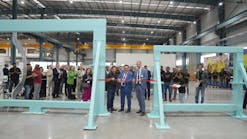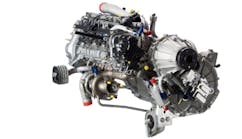By Joe Escobar
Nickel-cadmium batteries, generally referred to as NiCad batteries, are in wide use in the aviation industry. With proper maintenance, they can provide years of trouble-free service. Let's take a look at the basic construction of these batteries as well as some maintenance issues to keep in mind when working with them.
Construction
The cell is the basic unit of the NiCad battery. It consists of positive
and negative plates, separators, electrolyte, cell vent, and cell container. The positive plates are made from a porous plaque on which nickel-hydroxide has been deposited. The negative plates are made from similar plaques on which cadmium-hydroxide is deposited. In both cases the porous plaque is obtained by sintering nickel powder nickel powder to a fine-mesh wire screen. Sintering is a process which fuses together extremely small granules of powder at a high temperature. After the active positive and negative materials are deposited on the plaque, it is formed and cut into the proper plate size. A nickel tab is then welded to a corner of each plate and the plates are assembled with the tabs welded to the proper terminals. The plates are separated from each other by a continuous strip of porous plastic.
The electrolyte used in the NiCad battery is a 30 percent solution of potassium hydroxide (KOH) in distilled water. The specific gravity of the electrolyte remains between 1.240 and 1.300 at room temperature. It must be noted that no appreciable changes occur in the electrolyte during charge or discharge. Because of this, the battery charge cannot be determined
by a specific gravity check of the electrolyte. The electrolyte level should be maintained just above the tops of the plates.
Charging NiCad batteries
When a charging current is applied to a NiCad battery, the negative plates lose oxygen and begin forming metallic cadmium. The active material of the positive plates, nickel-hydroxide, becomes more highly oxidized. This process continues while the charging current is applied or until all the oxygen is removed from the negative plates and only cadmium remains.
Toward the end of the charging cycle the cells emit gas. This will also occur if the cells are overcharged. This gas is caused by decomposition of the water in the electrolyte into hydrogen at the negative plates and oxygen at the positive plates. The voltage used during charging, as well as the temperature, determines when gassing will occur. To completely charge a NiCad battery, some gassing, however slight, must take place; thus some water will be used.
Discharge
The chemical action is reversed during discharge. The positive plates slowly give up oxygen, which is regained by the negative plates. This process results in the conversion of the chemical energy into electrical energy. During discharge the plates absorb a quantity of the electrolyte. On recharge the level of the electrolyte rises and at full charge the electrolyte will be at its highest level. Therefore, water should be added only when the battery is fully charged.
Changing from lead-acid to NiCad
The NiCad battery is usually interchangeable with lead-acid batteries.
When replacing a lead-acid battery with a NiCad battery, the battery compartment must be clean, dry, and free of all traces of acid from the old battery. The compartment must be washed out and neutralized with ammonia or boric acid solution, allowed to dry thoroughly, and then painted with an alkali-resisting varnish.
The pad in the battery sump jar should be saturated with a 3 percent (by weight) solution of boric acid and water before the battery vent system is connected.
Servicing NiCad batteries
There are significant differences in the servicing methods required for the NiCad batteries and those of the lead-acid batteries. The most important points to be observed are as follows.
A separate storage and maintenance area should be provided for NiCad batteries. The electrolyte is chemically opposite to the sulphuric acid used in a lead-acid battery. Fumes from a lead-acid battery can contaminate the electrolyte in a nickel-cadmium battery. This precaution should include equipment such as hand tools and syringes used with lead-acid batteries. Indeed, every possible precaution must be taken to keep anything containing acid away from NiCad battery shops.
The potassium hydroxide electrolyte used in NiCad batteries is extremely corrosive. Protective equipment such as goggles, rubber gloves, and rubber
aprons should be used when handling and servicing batteries. Suitable washing facilities need to be provided in case electrolyte is spilled on clothing or the skin. Any such exposure to electrolyte should be rinsed immediately with water or vinegar, lemon juice, or a boric acid solution. Remember, when potassium hydroxide and distilled water are mixed to make the electrolyte, the potassium hydroxide should be slowly added to the water, not vice versa.
Avoid using a wire brush to clean the battery. Severe arcing may result if a wire brush is used. In addition, the vent plugs should be closed during the cleaning process and the battery should never be cleaned with acids, solvents, or any chemical solution. Spilled electrolyte can react with carbon dioxide to form crystals of potassium carbonate. These, which are non-toxic and non-corrosive, can be loosened with a fiber brush and wiped off with a damp cloth. When potassium carbonate forms on a properly serviced battery it may indicate the battery is overcharging because the voltage regulator is out of adjustment.
Additional water should never be added to the battery earlier than three or four hours after it has been fully charged. If you need to add water,
only use distilled or demineralized water. In addition, be careful not to overservice the battery with water. If you do and have to remove some of the liquid, you will reduce the concentration of potassium hydroxide in the cell. This will affect its operation.
Since the electrolyte does not react chemically with the cell plates, its specific gravity does not change appreciably. Thus, it is not possible to determine the state of charge of a NiCad battery with a hydrometer. In addition, a NiCad battery's charge cannot be determined by a voltage test because the voltage of a NiCad battery remains constant during 90 percent of the discharge cycle.
Servicing intervals
NiCad batteries should be serviced at regular intervals based on experience,
since water consumption varies with ambient temperature and operating methods. At greater intervals the battery should be removed from the aircraft and given a bench check in the shop.
If a battery is completely discharged some cells can reach zero potential and charge in the reverse direction. This could affect it in such a manner that it will not retain a full capacity charge. If this happens, the battery should be discharged and each cell balanced before recharging the battery. This is known as equalization.
Charging can be accomplished by either the constant-voltage or the constant-current method. For the constant potential charging, maintain the charging voltage constant until the charging current decays to 3 amperes or less assuring that the battery cell temperature does not exceed 100 degrees Fahrenheit and the voltage begins to decline.
Trickle charging
Trickle charging is the process of keeping a battery in active stand-by condition by continuously charging the battery in an overcharge condition. Although some manufacturers do not recommend this procedure for charging, some operators have chosen this method to charge their NiCad batteries. Keep in mind that using a trickle charger will consume water over time because of the gassing effect discussed earlier. You must adjust the electrolyte
level before placing the battery onboard the aircraft. If not, there is a risk of battery incident because the cells may dry out before the normal end of the maintenance interval.
Safe handling
NiCad batteries are generally not dangerous during normal operation and are built sturdily enough to withstand puncture from typical damage scenarios. However, if for some reason they are ruptured, they can be quite hazardous. The potassium hydroxide in NiCad batteries is an alkali solution that is dangerous and highly corrosive to skin. This fluid can be released in the event of damage to the battery. If it comes in contact with the skin, it can cause burns. Contact with the eyes can result in permanent eye damage. It is toxic if ingested. Avoid breathing the fumes in a closed area since that can lead to irritation in the mouth, throat, and lungs. Long-term exposure to potassium hydroxide fumes can cause liver and kidney disorders, and it has been identified by OSHA as a possible carcinogen.
Anyone handling NiCad batteries should avoid contact with the inner components and wash hands thoroughly after handling. If you have a spill, make sure to wear protective clothing including vinyl or PVC gloves, eye goggles, and a face shield. Of course, never attempt to clean up a hazardous material spill unless you have received proper training.
Shipment
Keep in mind that NiCad batteries contain hazardous materials and should
be marked and documented in accordance to current IATA regulations (UN2797 or UN2800 as applicable) governing the shipment of vented NiCad batteries.
In the end, you can help ensure the long life of your NiCad batteries by good maintenance practices. All personnel that maintain or even handle them should be trained on the proper practices. Make sure to follow all manufacturer recommended procedures. If possible, take advantage of any training available from the manufacturer or their distributors. In the end, knowing the proper procedures can ensure a long, safe life of your battery.
Additional ReSources
FAA Advisory Circular 00-33B
Nickel-Cadmium Battery Operational, Maintenance, and Overhaul Practices.
Marathon Batteries
P.O. Box 8233
Waco, TX 76714
(254) 776-0650
www.mptc.com
Saft
711 Industrial Boulevard
Valdosta, Georgia 31601
(229) 247-2331
www.saftbatteries.com





